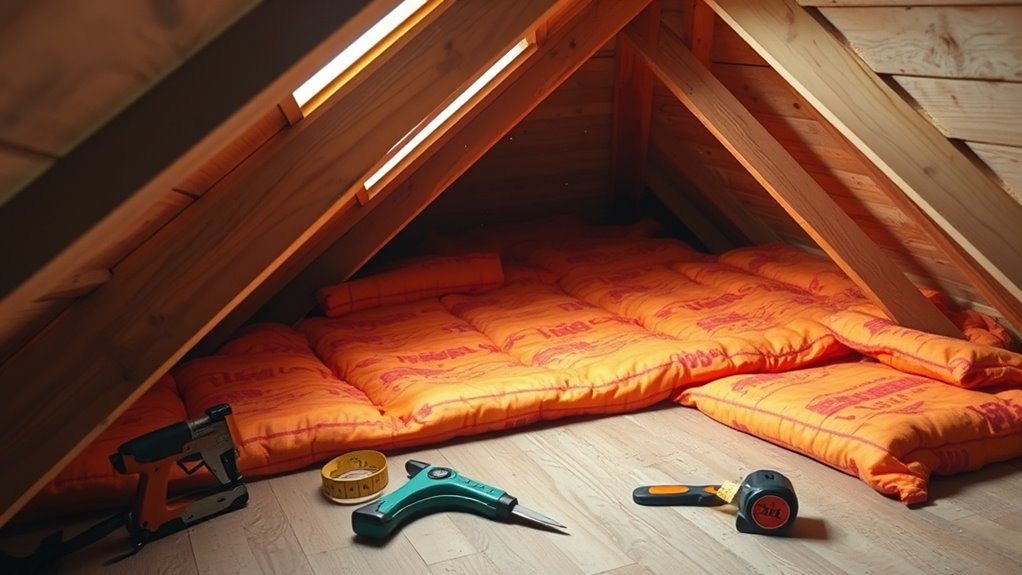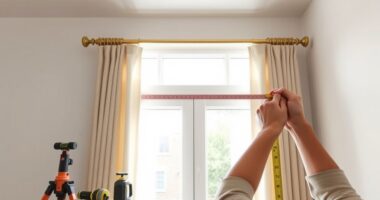To insulate your attic effectively, start by clearing away debris or damp insulation. Choose suitable materials like fiberglass batts, spray foam, or blown-in cellulose, ensuring you meet recommended R-values for your climate. Seal all air leaks around vents, wiring, and access points to prevent drafts. Improving ventilation and moisture control helps maintain a balanced temperature and prevents mold. Proper installation and ongoing maintenance are key—continue exploring to learn more about creating a comfortable, energy-efficient attic.
Key Takeaways
- Assess existing insulation and ventilation systems to identify areas needing improvement or replacement.
- Choose appropriate insulation materials (fiberglass, spray foam, or cellulose) and ensure even distribution to meet R-value requirements.
- Seal air leaks around attic access points, wiring, and vents to prevent drafts and humidity ingress.
- Add or upgrade ventilation systems, such as soffit and ridge vents, for continuous airflow and moisture control.
- Regularly inspect and maintain insulation and ventilation to sustain energy efficiency and structural integrity.

Insulating your attic is one of the most effective ways to improve your home’s energy efficiency and reduce heating and cooling costs. Proper insulation helps keep warm air inside during winter and blocks heat from entering during summer. But insulation alone isn’t enough; you also need to focus on ventilation improvements and moisture control. Good ventilation prevents excess humidity from building up, which can cause insulation to become less effective and lead to issues like mold and wood rot.
Start by inspecting your attic to identify existing ventilation systems. Ventilation improvements may include adding or upgrading intake vents at the soffits and exhaust vents at the ridge or roof vents. This setup creates a continuous airflow that helps remove moisture-laden air and maintains a balanced attic temperature. Adequate ventilation reduces the risk of condensation, which can occur when warm, moist air contacts cooler surfaces. Moisture control is essential because excess humidity can compromise your insulation’s effectiveness and lead to structural damage over time.
Before installing new insulation, clear out any debris or old insulation that’s damp or moldy. This step ensures your new insulation performs at its best. When choosing insulation material, consider options like fiberglass batts, spray foam, or blown-in cellulose, based on your attic’s configuration and your budget. As you lay insulation, make sure it’s evenly distributed and thick enough to meet recommended R-values for your climate zone. Be cautious around recessed lighting or other heat-producing fixtures; these areas may require special covers or insulation barriers to prevent fire hazards.
While adding insulation, pay close attention to sealing air leaks around attic access points, wiring, and vents. Proper sealing improves energy efficiency by preventing drafts, but it also plays a role in moisture control. Sealing gaps helps reduce the influx of humid outdoor air, which can raise indoor moisture levels. Keep in mind that insulation and ventilation work hand in hand; insulating without proper ventilation can trap moisture, leading to mold and degrading your insulation’s performance.
Ultimately, maintaining a balanced approach with effective ventilation improvements and moisture control will maximize your attic’s insulation benefits. This not only boosts your home’s energy efficiency but also prolongs the lifespan of your roof and structural components. Regular inspections and adjustments ensure your attic remains well-insulated, dry, and ventilated, saving you money and preventing costly repairs in the long run.
Frequently Asked Questions
What Is the Ideal R-Value for Attic Insulation?
The ideal R-value for attic insulation depends on your climate and local insulation standards. Typically, you should aim for a thermal resistance of R-30 to R-60 in colder regions, ensuring good energy efficiency. By choosing insulation with the right R-value, you meet insulation standards, reduce heat transfer, and keep your home comfortable. Always check your area’s building codes to determine the recommended R-value for your attic space.
How Often Should Attic Insulation Be Replaced?
Back in the day, attic insulation was a bit of a mystery, but now you know better. You should swap out your insulation materials every 15-20 years, especially if you notice mold, pests, or moisture issues. Proper attic ventilation helps prolong the life of your insulation. Regular inspections ensure your attic stays energy-efficient and safe, saving you money in the long run and keeping your home cozy year-round.
Can I Install Insulation Myself Safely?
You can definitely install insulation yourself safely if you follow proper DIY safety measures. Wear protective gear like gloves, goggles, and a mask to avoid irritation from insulation materials. Make sure your attic is well-ventilated, and handle insulation carefully to prevent dust or fibers from becoming airborne. Read the manufacturer’s instructions thoroughly, and consider consulting local building codes to guarantee your project meets safety standards.
What Are Signs My Attic Needs More Insulation?
Think of your attic as the heart of your home’s energy efficiency. If you notice drafts, uneven heating, or skyrocketing utility bills, it’s a sign your attic needs more insulation. Conduct air leak detection to find drafts and check if your insulation materials have settled or become sparse. These signs reveal where your home’s warmth is escaping, so adding insulation can seal those leaks and keep your home cozy year-round.
Does Insulation Help Reduce Energy Bills Significantly?
Insulation can considerably lower your energy bills by keeping your home warmer in winter and cooler in summer. Proper attic ventilation works hand-in-hand with insulation, preventing moisture buildup and mold prevention. When your attic is well-insulated, you reduce the strain on your heating and cooling systems, saving you money. Plus, it helps maintain a healthy environment by controlling humidity and preventing mold growth, making your home more comfortable and energy-efficient.
Conclusion
Now that you’ve insulated your attic, you’ll feel like you’ve just given your home superpowers! Say goodbye to icy drafts and sky-high energy bills—your house will be so cozy, it might start asking for a blanket. With this simple upgrade, you’re basically turning your attic into a fortress of comfort, protecting you from the elements like a superhero shielding the city. So go ahead, enjoy your new, ultra-efficient, super-insulated space—your home has never been this awesome!









